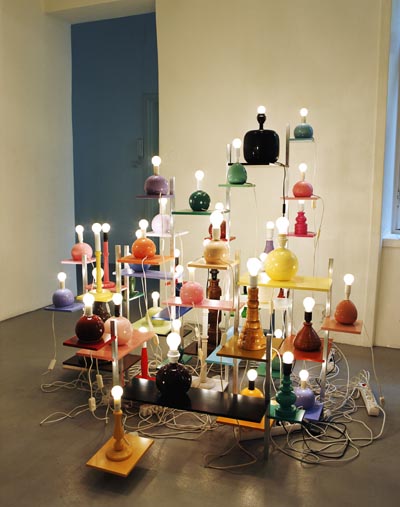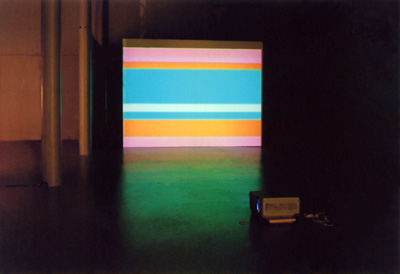 Jacob Dahlgren: Item 2; Bohemians, 2004 Jacob Dahlgren, Katarina Löfström Click for English text Utställningen med Jacob Dahlgren och Katarina Löfström på Malmö Konsthall presenterar två separata konstnärskap. Men mellan deras verk sker det intressanta möten - estetiska, formella, innehållsmässiga - inte minst mellan det konkreta, det representativa och det abstrakta. Dahlgrens och Löfströms konst är i första hand inte teoretisk eller konceptuell utan "visuell och emotionell". En central aspekt av utställningen är hur det till synes enkla, genom konstnärens transformering och vår perception (och fantasi) blir något sensuellt, poetiskt och betydelsefullt. Genom att skapa vad vi upplever som abstrakta bilder kopplar konstnärerna oss, å ena sidan, fria från den rena representationens begränsande bokstavlighet och möjliggör mångtydiga berättelser, och känslor, hos oss betraktare. Å andra sidan poängteras också det konkreta (material och form) samt det fragmentariskt representativa vilket är deras sätt att samtidigt framställa innehåll och skapa en utgångspunkt för vår läsning. Jacob Dahlgren är målare och skulptör, men han arbetar i stort sett utan måleriets och skulpturens traditionella material. Hans abstrakta verk utgörs istället av ting som vi omges av i vår vardag. Det kan vara galgar, kaffekoppar, lampor eller som i utställningen på Malmö Konsthall, en rad olika material. Arrangerade: till exempel staplade på varandra förlorar delarna sin tänkta funktion, sitt ursprungliga värde, och blir delar av något helt nytt. De blir material att måla med, de blir färg och form som ligger till grund för spännande visuella upplevelser och en slags "öppen" och demokratisk estetik vilken skruvar till våra invanda föreställningar. Genom att medvetet missförstå ett av Marcel Duchamps berömda resonemang kan vi utveckla (den möjligen provocerande) tanken om Jacob Dahlgrens verk på Malmö Konsthall som måleri. Duchamps enkla konstaterande: att även den mest komplicerade målning är uppbyggd av redan existerande material (och därmed är att betrakta som en "readymade") öppnar nämligen upp den logiska möjligheten att faktiskt kunna måla även med okonventionella former av färg - i princip med vad som helst. Men en svala gör ingen sommar och en disktrasa gör ingen målning. Överflödet är en förutsättning för att Dahlgrens måleriskt abstrakta strategi skall fungera. I "Colour reading and contexture" (2005) är det den absurda mängden material som skapar den koncentration och kompakthet som gör verket så visuellt intagande, sensuellt och formellt intressant.  Katarina Löfström: Hang Ten Sunset, 2000 DVD-projection with sound Katarina Löfström arbetar med animerad video som relaterar till måleri och, i senare arbeten, även till teckning. I sina verk kombinerar hon det representativa och vardagliga med det abstrakta. "Hang Ten Sunset" (2000), ett av de två verk som visas på Malmö Konsthall, bär otvivelaktigt på arvet från modernismens "färgfältsmåleri" (colour field painting). Men Löfström leker också med en annan typ av kultur. Verket återkallar, med ledhjälp av dess titel, det glassiga 80-talet: ett surfarsamhälle iklätt tvärrandiga t-shirts på en strand vid en kitschig solnedgång. Att på detta sätt blanda det populärkulturella med konsthistoria och rent visuella, ibland hypnotiska, egenskaper är typiskt för hennes arbeten. I "An Island" (2004) är utgångspunkten i verket nöjesfältet Gröna Lund - i vardagen präglat av stress, stoj och stim men i Löfströms verk istället av ett meditativt lugn. Men det som mot bakgrund av dessa tankar och idéer är intressant är inte referenserna i sig - leken med historien, hyllningen (eller kritiken) - utan att hennes "orena" (och inte ens helt nonfigurativa) verk på sätt och vis gör det som så många av modernismens abstrakta målare, genom sin purism, försökte åstadkomma - men bättre. Befriad från historia, teori och romantiseringen av Konsten förkroppsligar hon deras dröm om berättelser i ett abstrakt språk av färg och form, fri att uttrycka mystiska, spirituella krafter och känslor direkt. Katarina Löfström lyckas förvandla det dunkla till något tydligt, utan att för den skull göra det möjligt att förklara i ord. Jacob Dahlgren och Katarina Löfström är båda födda 1970, verksamma i Stockholm och utbildade på Kungliga Konsthögskolan respektive Konstfack. Utställningar: 23.6. - 14.8.2005 Öppettider: Alla dagar 11-17, Onsdagar 11-21 Stängt: Midsommarafton, Midsommardagen, 24/12, 25/12, 31/12 samt när vi byter utställning Malmö Konsthall S:t Johannesgatan 7 S-200 10 Malmö Telefon +46 40 34 12 86 (Bookings and information) Fax +46 40 30 15 07 Email info.konsthall@malmo.se www.konsthall.malmo.se Jacob Dahlgren, Katarina Löfström The exhibition at Malmö Konsthall of works by Jacob Dahlgren and Katarina Löfström presents two separate artists. But between their works interesting encounters arise - aesthetic, formal, and in terms of content - not least between the concrete, the representative, and the abstract. The two artists' works are primarily neither theoretical nor conceptual but "visual and emotional". A central aspect of the exhibition is the way in which things that are apparently simple become - through their transformation by the artist and our own perception (and imagination) - something sensual, poetic and significant. By creating what we experience as abstract images, the artists on the one hand set us free from the limiting literalness of pure representation and make possible narratives (and emotions) with multiple layers of meaning in us, the observers. On the other hand, the artists also stress the concrete aspects (materials and form) as well as the fragmentarily representative, which is their way of simultaneously presenting content and creating a starting point for our interpretation. Jacob Dahlgren is a painter and sculptor but he works to a large extent without the traditional materials of painting and sculpture. Instead, his abstract works consist of objects which surround us in our everyday life. They might be coat-hangers, coffee mugs, lamps, or, as in this exhibition at Malmö Konsthall, a range of different materials. Arranged (for instance stacked on top of one another), the individual objects lose their intended function, their original value, and become part of something completely new. They become materials with which to paint; they become colours and shapes which form the basis of exciting visual experiences and a kind of "open" and democratic aesthetics which challenges our ingrained ideas. By deliberately misunderstanding one of Marcel Duchamp's famous arguments, we can develop the (possibly a provocative) idea that Jacob Dahlgren's work at Malmö Konsthall is a form of painting. For Duchamp's simple observation that even the most complex painting is constructed of pre-existing materials (and is therefore to be regarded as a readymade), opens up the logical possibility of in fact being able to paint even with unconventional forms of paint - in principle with anything at all. But one swallow does not a summer make, nor does one dishcloth make a painting. Superfluity is a prerequisite if Dahlgren's painterly abstract strategy is to work. In "Colour reading and contexture" (2005), it is the absurd amount of materials which creates the concentration and compactness that make the work so visually captivating, sensual and interesting in terms of its form. Katarina Löfström works with animated videos which relate to painting, and, in her later works, also to drawing. In her works she combines the representative and the everyday with the abstract. "Hang Ten Sunset" (2000), one of the two works shown at Malmö Konsthall, undeniably bears the legacy of modernism's colour field painting. But Löfström also plays with another kind of culture. Aided by its title, the work recalls the flashy decade of the 1980s - a surfer society clothed in horizontally striped T-shirts on a beach in front of a kitschy sunset. Combining in this way aspects of popular culture with art history and purely visual, sometimes hypnotic qualities is typical of her work. In "An Island" (2004), the starting point is in fact the Stockholm amusement park Gröna Lund - in real life characterised by stress, hubbub and noise but which in Löfström's work has instead a meditative calm. But what is interesting in view of these thoughts and ideas are not the references themselves - the playing with history, the praise (or criticism) - but rather the fact that her "impure" (and not even completely non-figurative) works in a way achieve what so many of modernism's abstract painters, through their purism, tried to achieve - but better. Liberated from history, theory and the romanticisation of Art, she embodies their dream of narratives in an abstract language of colour and form, free to directly express mystical, spiritual forces and emotions. Katarina Löfström succeeds in transforming the obscure into something clear, without thereby making it possible to explain in words. Jacob Dahlgren and Katarina Löfström were both born in 1970. They are both based in Stockholm and trained there at the Royal University College of Fine Arts and the University College of Arts, Crafts and Design respectively. Exhibition: June 23 - August 14 2005 Opening hours: daily 11 am - 5 pm, Wed 11 am - 9 pm |